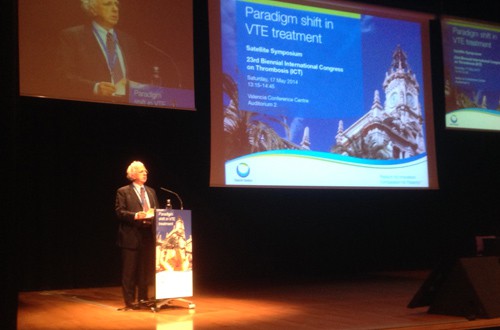
Prof Giancarlo Agnelli speaking at the Biennial International Congress on Thrombosis
Doctors in Europe are increasingly favouring the new generation of anticoagulant drugs to treat and prevent blood clot, according to baseline data from an on-going study.
The PREFER study, which is supported by Japanese pharma company Daiichi Sankyo, aims to create a European registry in venous thromboembolism (VTE) – a condition with more than one million events in Europe each year but where there is limited data on current disease management.
Early results were presented at Biennial International Congress on Thrombosis in Valencia last week, with PREFER demonstrating that – although standard therapy heparin is still the most commonly used treatment for VTE – novel anticoagulants are now almost as popular a choice as warfarin in patients under the age of 65.
These new medicines have only been on the market in Europe since 2011 when Boehringer Ingeheim won approval for Pradaxa (dabigatran etexilate), and it was followed by Bayer and Johnson & Johnson’s Xarelto (rivaroxaban) and Bristol-Myers Squibb and Pfizer’s Eliquis (apixaban).
Market predictions are high for all three oral drugs as they offer a safer and more convenient alternative to previous treatments by avoiding specific dosing requirements and demonstrating fewer side effects.
Daiichi has its own drug in the works too, with edoxaban currently under review in both the US and the EU for once-daily use for the treatment and prevention of recurrence of VTE, as well as for use in the prevention of stroke in patients with atrial fibrillation.
The baseline results of PREFER go some way to justify Daiichi’s decision to invest in this new area of treatment, despite concerns that the higher cost of these new drugs might put off some healthcare systems in Europe from recommending them.
A ‘paradigm shift’ in care?
Speaking to PMLiVE at the event, one of the study’s leaders Prof Giancarlo Agnelli, said that Europe was experiencing a “paradigm shift” in the care of VTE, which comprises the life-threatening conditions deep vein thrombosis (DVT) and pulmonary embolism (PE).
“We are seeing a move to these new agents as they are more comfortable and side effects are less common. In VTE, it is difficult to explain why someone would not use a new compound, except for the cost.”
The class of drugs has, however, faced some safety questions. Two years ago the EMA asked Boehringer to give clearer guidance on the risk-benefit balance of Pradaxa and more recently US regulators said they would launch a large-scale study of that drug’s safety outcomes.
This greater scrutiny notwithstanding, VTE has serious consequences – it leads to 500,000 deaths per year in Europe and, Prof Agnelli said, treatment already has a substantial economic burden.
“The most commonly-used treatments are quite cheap, but the system is quite complicated because a specific dose does not exist,” he said. “In order to reach a dose for a patient you need a blood examination system, which is itself quite cumbersome.”
Treatment choices do vary between countries, however, with PREFER sourcing data from France, Germany, Austria, Switzerland, Italy, Spain and the UK.
In Spain and Italy, both of which have healthcare systems that have been hit hard by the financial crisis, the use of new anticoagulants was very limited, with less than 10 per cent of patients on one of these treatments.
The story is different in the UK, Germany and France, however, where use is approaching 50 per cent, thanks to the drugs being recommended by the respective health technology assessment (HTA) bodies of the regions.
“There is quite a remarkable difference across different countries,” said Prof Agnelli. “I think the conclusion you can make is that when a new anticoagulant is available, like in Germany, then it is very accepted.”
Daiichi also presented data from its HOKUSAI-VTE trial, which demonstrated that edoxaban was non-inferior to warfarin in patients with VTE while also holding a superior safety record.




